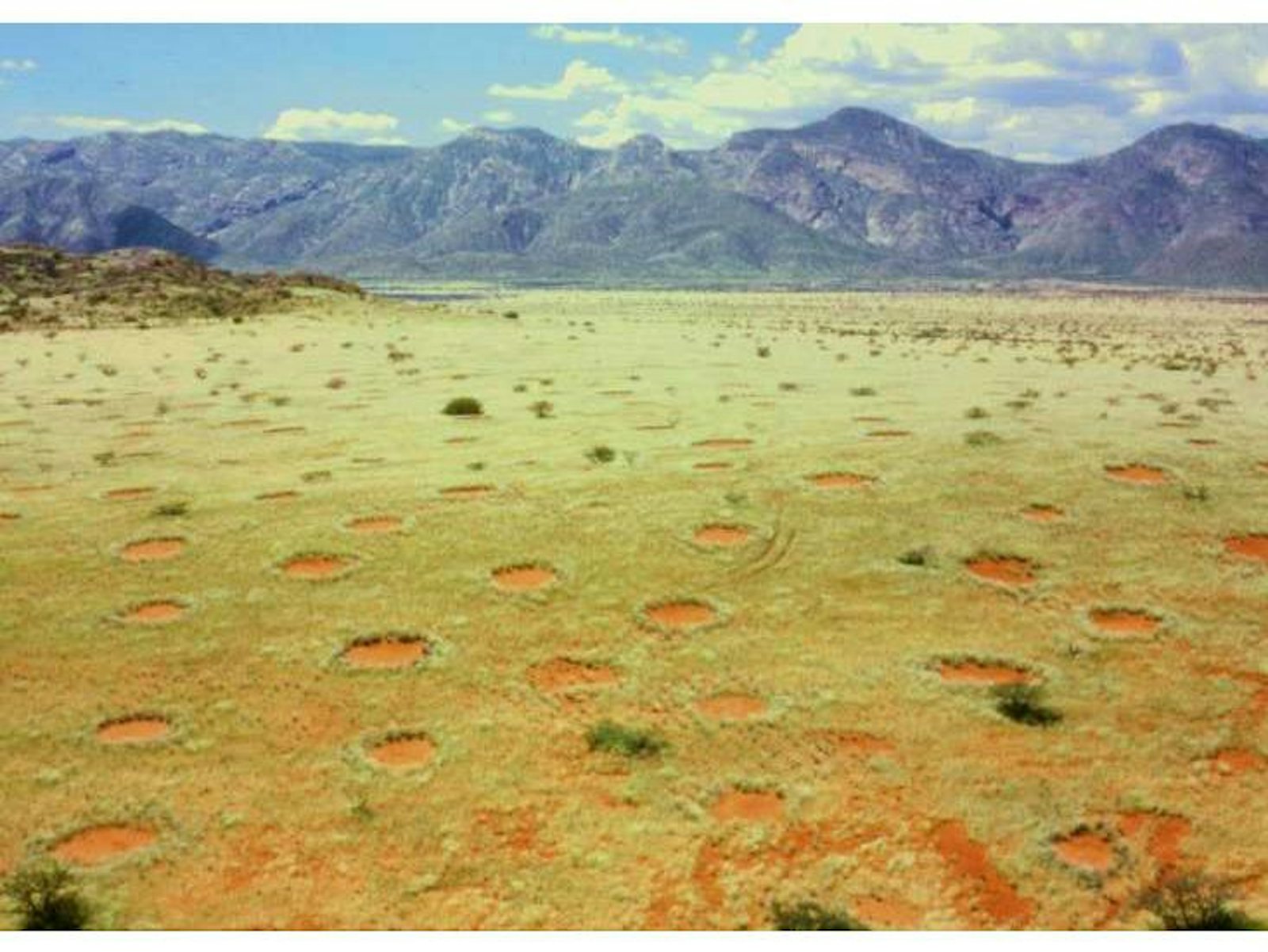The Himba bushmen who inhabit the Namibian grasslands—a 1,200-mile-long swath of land running from Angola into South Africa—have come up with different stories over the years to explain the unusual circular bare patches, called “fairy circles,” dotted throughout the grassy expanse. These reddish-hued circles, sometimes several feet in diameter, are dubbed “footprints of the gods,” and are considered to be the work of spirits or the Himbas’ mythical ancestor Mukuru—although some imaginative tour guides have attributed the phenomenon to an underground dragon whose poisonous breath kills any vegetation within the circles.
Those tour guides get points for creativity, but scientists have their own explanations for the unlikely occurrence of fairy circles. In 2012, Florida State University biologist Walter Tschinkel studied satellite images of the circles and found that over the course of four years, some circles appeared and some vanished. From that data, Tschinkel concluded the fairy circles had a “lifespan” of about 41 years. Termite activity was the most logical answer, but he couldn’t find any evidence of that, nor was there anything unusual about the soil that could have caused the bare patches.
It could be termites. Earlier this year, Norbert Juergens, an ecologist at the University of Hamburg in Germany, published a paper in Science suggesting that the rings were the work of a species of termite called Psammmotermes allocerus. His conclusions were based on a sampling of some 1,200 fairy circles, collected over the course of 40 trips to Africa; the only element they all had in common was the sand termite. Apparently the little critters escaped Tschinkel’s notice because they are “extremely clandestine,” only coming out at night, and their telltale tunnels are hard to detect, in part because this species doesn’t build above-ground nests.
Juergens posits that as they burrow, the sand termites damage the roots of plants, which lets scarce rainwater seep into the sandy soil, instead of being sucked up immediately by the plants. So the termites may maintain the circles to serve as water traps, enabling the bugs to survive. This could also explain why the circles are often surrounded by especially lush high grass: That vegetation gets more water because there is less competition from neighboring plants. During droughts, as the termites fan outward for food, the circles expand in diameter.
So the termites may maintain the circles to serve as water traps, enabling the bugs to survive.
There are some problems with this hypothesis; even Juergens admits he can’t explain why the circles eventually disappear. And while at least one termite specialist, Vivienne Uys of the Agricultural Research Council in Pretoria, acknowledged to the New York Times that such behavior is consistent with this species, it’s also possible that he could be confusing correlation with causation. “If Juergens claims termites are killing the grass, he’s got to show that they’re actually living plants,” Uys told the Times, “That’s not easy to do, and he didn’t do it.”
Now Michael Cramer, a “plant ecophysiologist” at the University of Cape Town, has published his own paper in PLoS ONE positing that fairy circles have little to do with termites and everything to do with a kind of self-organizing spatial patterning that is a hallmark of normal plant growth. For Cramer, it all comes down to competition between plants as their roots vie for precious water and soil nutrients.
His research builds on prior work, including computer modeling that showed plant growth might play a role in the formation of these fairy circles, as well as gaps or bands. Cramer and his team combined Google Earth images of fairy circle sites across Namibia with environmental data, including soil samples. The resulting model predicted with 95% accuracy the actual distribution of the existing circles. It turns out that rainfall plays a key role in that distribution, and variances in rainfall could explain why circles appear and disappear.
Such patterning turns out to be quite common in arid climates. The Namibian fairy circles are similar to South Africa’s heuweltjies, South America’s campos de murundus, and mima mounds in the US, and Cramer thinks a similar mechanism could account for these as well. This might just be something that happens in dry areas with sandy soil.
There are also other unlikely ring-like formations that show up in natural landscapes from time to time, notably fairy rings—mushrooms that grow in wide arcs or circles that can span as much as than 30 feet in diameter. The mysterious seven-foot diameter patterned circles discovered along the ocean floor in 1995 were found recently to be the work of male pufferfish to “entertain lady callers.”
And while some attribute the plethora of crop circles to mini-whirlwinds or aliens, the ones in Wiltshire, England, at least, are the work of a group of local artists who call themselves The Circlemakers.
Like the termite theory, Cramer’s plant root hypothesis is absent a smoking gun—it’s based on an interesting correlation, which is why he acknowledges that until scientists find a way to perform direct experiments on the formations, neither prevailing theory holds sway. But whether it’s termites, plant roots, poisonous dragon breath, or Mukuru’s handiwork (or aliens!), the Himba, at least, have put the Namibian fairy circles, and the lush grass that grows near them, to good practical use. Put up some temporary fencing and voila! You’ve got a handy makeshift corral to feed your cattle and keep them safe overnight from predators.
Jennifer Ouellette is a science writer and the author of The Calculus Diaries and the forthcoming Me, Myself and Why: Searching for the Science of Self. Follow her on Twitter @JenLucPiquant.


























